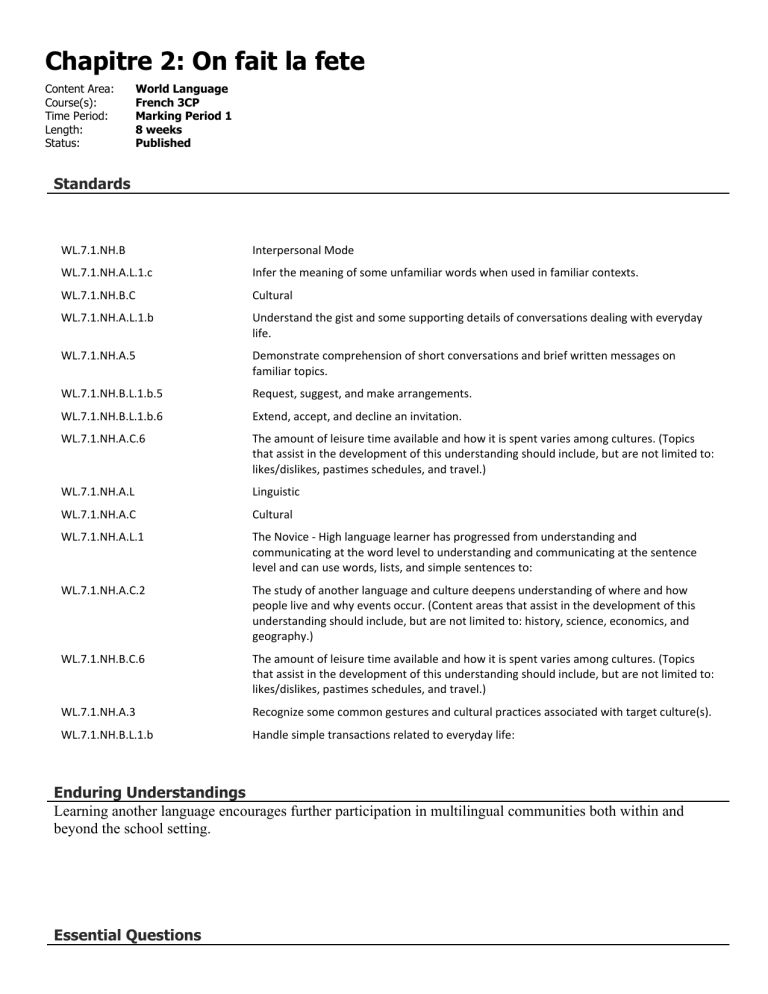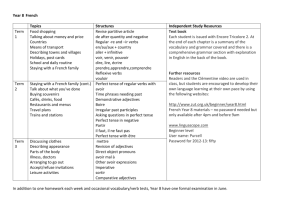
Chapitre 2: On fait la fete Content Area: Course(s): Time Period: Length: Status: World Language French 3CP Marking Period 1 8 weeks Published Standards WL.7.1.NH.B Interpersonal Mode WL.7.1.NH.A.L.1.c Infer the meaning of some unfamiliar words when used in familiar contexts. WL.7.1.NH.B.C Cultural WL.7.1.NH.A.L.1.b Understand the gist and some supporting details of conversations dealing with everyday life. WL.7.1.NH.A.5 Demonstrate comprehension of short conversations and brief written messages on familiar topics. WL.7.1.NH.B.L.1.b.5 Request, suggest, and make arrangements. WL.7.1.NH.B.L.1.b.6 Extend, accept, and decline an invitation. WL.7.1.NH.A.C.6 The amount of leisure time available and how it is spent varies among cultures. (Topics that assist in the development of this understanding should include, but are not limited to: likes/dislikes, pastimes schedules, and travel.) WL.7.1.NH.A.L Linguistic WL.7.1.NH.A.C Cultural WL.7.1.NH.A.L.1 The Novice - High language learner has progressed from understanding and communicating at the word level to understanding and communicating at the sentence level and can use words, lists, and simple sentences to: WL.7.1.NH.A.C.2 The study of another language and culture deepens understanding of where and how people live and why events occur. (Content areas that assist in the development of this understanding should include, but are not limited to: history, science, economics, and geography.) WL.7.1.NH.B.C.6 The amount of leisure time available and how it is spent varies among cultures. (Topics that assist in the development of this understanding should include, but are not limited to: likes/dislikes, pastimes schedules, and travel.) WL.7.1.NH.A.3 Recognize some common gestures and cultural practices associated with target culture(s). WL.7.1.NH.B.L.1.b Handle simple transactions related to everyday life: Enduring Understandings Learning another language encourages further participation in multilingual communities both within and beyond the school setting. Essential Questions How does our daily routine in the United States compare to the daily routine of a young person living in France? How does your routine during the week compare to your routine during the weekend? How does grammar in French differ from grammar in English? How does a student develop grammatical accuracy and consistency in the target language? Knowledge and Skills Vocabulary associated with holidays and celebrations. Vocabulary associated with objects that we use to celebrate and plan a party. Conjugation of the composed past tense with ETRE & AVOIR. Differentiating between a the composed past tense with ETRE & AVOIR. Given a variety of resources teachers will be able to do the following. Categorize the steps necessary to organize and plan a party. Identify what the composed past tense is in French and how to conjugate it. Distinguish between the composed past tense with AVOIR & ETRE. Write a mini paragraph explaining how you celebrate birthdays and celebrations and correctly conjugate verbs in the present and composed past tenses. Interview a partner in class and ask him when, where, etc. he celebrates and what his preferences are on the topic. Classify verbs that are conjugated with ETRE & AVOIR. Determine when a verb will be conjuguated with ETRE & AVOIR. Create a dialogue about planning a party in the composed past tense. Create a presentation about planning a party for a famous French person. Transfer Goals Students will be able to effectively and independently interpret written text discussing the culture differences that exist between the French culture and their own culture. Students will be able to demonstrate a sensitivity to culture and context. Students will be able to communicate effectively in various real-world situations with diverse audiences in diverse environments. Resources Bien Dit Level 2 Bien Dit Online Book resources Power Point Presentations used to present new material. Workbook activities on material Paired Practice activities Textbook activities.
